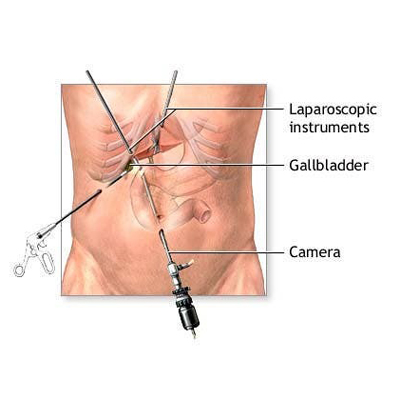A cholecystectomy is a surgical procedure to remove your gallbladder — a pear-shaped organ that sits just below your liver on the upper right side of your abdomen. Your gallbladder collects and stores bile — a digestive fluid produced in your liver. A cholecystectomy is a common surgery, and it carries only a small risk of complications. In most cases, you can go home the same day of your cholecystectomy.
A cholecystectomy is most commonly performed by inserting a tiny video camera and special surgical tools through four small incisions to see inside your abdomen and remove the gallbladder. Doctors call this a laparoscopic cholecystectomy. In some cases, one large incision may be used to remove the gallbladder. This is called an open cholecystectomy.

During a laparoscopic cholecystectomy, the surgeon makes four small incisions in your abdomen. A tube with a tiny video camera is inserted into your abdomen through one of the incisions. Your surgeon watches a video monitor in the operating room while using surgical tools inserted through the other incisions in your abdomen to remove your gallbladder.
Next you may undergo an imaging test, such as an X-ray or ultrasound, if your surgeon is concerned about possible gallstones or other problems in your bile duct. Then your incisions are sutured, and you're taken to a recovery area. A laparoscopic cholecystectomy takes one or two hours. A laparoscopic cholecystectomy isn't appropriate for everyone. In some cases your surgeon may begin with a laparoscopic approach and find it necessary to make a larger incision because of scar tissue from previous operations or complications.
During an open cholecystectomy, the surgeon makes a 6-inch (15-centimeter) incision in your abdomen below your ribs on your right side. The muscle and tissue are pulled back to reveal your liver and gallbladder. Your surgeon then removes the gallbladder.
The incision is sutured, and you're taken to a recovery area. An open cholecystectomy takes one or two hours.
Bile ducts are the drainpipes that connect your liver, pancreas and gallbladder, allowing bile to digest food and cleanse the organs of waste. When bile ducts become inflamed or obstructed, waste backs up from the liver and empties into the blood stream. You may experience pain and jaundice (yellowing of the skin and eyes). Surgery can help relieve your symptoms.

Draining the bile ducts requires the delicate touch of expertly trained gastroenterologists. We typically perform this minimally invasive procedure to relieve pain from biliary pancreatitis, bile duct obstructions and pancreatic stones.
We insert a small tube with a camera into your mouth and thread it to the bile duct. Then we may drain or place a stent in the tube to relieve pressure from bile buildup. If we find a cyst or tumor, we remove a tissue sample for testing (biopsy).
We place a small, expandable device (stent) into the duct. The device supports areas of the bile duct walls that have become weak from either a tumor or obstruction. Some stents are temporary, but some permanently keep the bile ducts open.
When bile ducts become blocked by tumors or cysts, we can reroute the path for bile to drain from the organs. We connect the healthy part of the blocked duct to a new, unblocked duct. Typically, we perform biliary bypasses for tumors that we are unable to completely remove.
Making use of both minimally invasive and robotic surgery to remove cancerous bile ducts and any other cancerous tissue nearby. These surgical techniques reduce pain, scarring and recovery time. You can quickly move on to the next step in your care, often chemotherapy or radiation therapy.